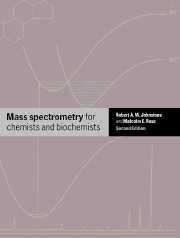Book contents
- Frontmatter
- Contents
- Introduction
- Acknowledgments
- Table of quantities
- List of abbreviations
- 1 The mass spectrum
- 2 Instrument design
- 3 Methods of ionization
- 4 Computers in mass spectrometry: data systems
- 5 Combined chromatography and mass spectrometry
- 6 Uses of derivatization
- 7 Quantitative mass spectrometry
- 8 Metastable ions and mass spectrometry/mass spectrometry
- 9 Theory of mass spectrometry
- 10 Structure elucidation
- 11 Examples of structure elucidation by mass spectrometry
- 12 Further discussion of selected topics
- References
- Index
10 - Structure elucidation
Published online by Cambridge University Press: 05 June 2012
- Frontmatter
- Contents
- Introduction
- Acknowledgments
- Table of quantities
- List of abbreviations
- 1 The mass spectrum
- 2 Instrument design
- 3 Methods of ionization
- 4 Computers in mass spectrometry: data systems
- 5 Combined chromatography and mass spectrometry
- 6 Uses of derivatization
- 7 Quantitative mass spectrometry
- 8 Metastable ions and mass spectrometry/mass spectrometry
- 9 Theory of mass spectrometry
- 10 Structure elucidation
- 11 Examples of structure elucidation by mass spectrometry
- 12 Further discussion of selected topics
- References
- Index
Summary
CLASSIFICATIONS OF MASS SPECTRA
Electron ionization mass spectra of many thousands of compounds of known structure have now been determined and collated and are available as ‘libraries’ of mass spectra. Published volumes of mass spectra, the contents of which are usually in the form of normalized tables of mass spectra, are available from various sources (section 12.5). If the mass spectrum of a substance of unknown structure has been obtained, it is useful to be able to sort through compilations of published spectra in order to compare them with it. In this comparative way, it may be possible to identify the unknown compound without needing to understand the mass spectrum at all. Even if the structure of an unknown substance can be deduced from its mass spectrum, the compilations are useful for confirming that structure. The task of searching manually through large compilations is tedious but preferable to looking through scattered research literature. Fortunately, searching through large compilations of mass spectra is a task ideally suited to a computer and automatic library searching has already been discussed (section 4.4.3). Of course, the classification of mass spectra in this way is of limited use if the mass spectrum of the substance to be identified has not been determined previously. In such circumstances, the mass spectrum must be interpreted by rationalizing the fragmentation pattern or subjected to computerized spectral interpretation (section 4.4.3). The remainder of this chapter is concerned largely with interpretation through rationalization of mass spectra.
- Type
- Chapter
- Information
- Mass Spectrometry for Chemists and Biochemists , pp. 325 - 396Publisher: Cambridge University PressPrint publication year: 1996

